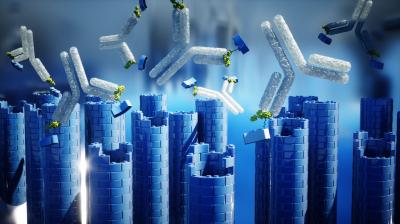December 3, 2019 -- Researchers from the University of Rome, Tor Vergata demonstrate a new model to control the construction of nanostructures using antibodies. The findings were published in Nature Communications on December 3.
In recent decades, scientists have become proficient at synthesizing DNA structures with complex geometric motifs. There are numerous applications for these nanostructures, but to be clinically relevant, the design, including self-assembly and disassembly must be guided by molecular cues pertinent to biology. The use of antibodies as biomolecular markers for control of assembly and disassembly processes has not been demonstrated.

The research team from the University of Rome, Tor Vergata has now provided evidence that it is possible to recruit antibodies as molecular builders to build or dismantle DNA nanostructures. They were intrigued by the idea of integrating antibody-induced regulation into DNA-based self-assembly for use in clinical settings. So, they demonstrated orthogonal regulation of DNA-based circuits with specific antibodies.
"This project started a couple of years ago when we realized that this amazing functionality of antibodies (recognize and bind to a specific molecule) could be repurposed for nanotech applications", says Francesco Ricci, professor at the University of Rome, Tor Vergata and senior author of the paper. "We had the idea of utilizing antibodies as molecular workers to build nanoscale structures".
"To do this, we employed DNA bricks that bind to each other and form nanostructures of tubular shape", says Simona Ranallo, a postdoc researcher at the University of Rome, and first author of the paper, "we then re-engineered such bricks with recognition tags (antigens) so that their assembly is initiated by a specific antibody. The nanotube structure can thus only built up when the antibody is present in the sample!"
"Antibodies are highly specialized workers" adds Ricci, "there are thousands of distinct antibodies in our body each recognizing its own antigen. We took advantage of this amazing feature and designed different bricks that can assemble with different specific antibodies." Despite the specificity of antibodies, the researchers built a generalizable model for any antibody for which an antigen can be attached to a DNA anchoring strand.
"We took a step further" continues Ricci, "we engineered our DNA bricks so that not only they assemble into the desired nanostructure in the presence of a specific antibody, but they can also be completely dismantled by a second antibody worker."
The researchers offer that the antibody-regulated DNA reactions and structures they developed may open the doors to new exciting possibilities with applications in point-of-care diagnostics, controlled drug-release and in-vivo imaging. This system could also refine current diagnostic and drug-delivery applications with increased control with specific antibodies. Leakage-free antibody controlled DNA circuits could also aid in the development of complex synthetic genetic circuits for cell-free synthetic biology applications.
Do you have a unique perspective on your research related to nanotechnology? Contact the editor today to learn more.
Copyright © 2019 scienceboard.net






